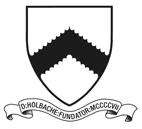Oswestry School
 | |
| Motto | "Non scholae, sed vitae discimus" (Latin: We Learn Not For School But For Life) |
|---|---|
| Established | 1407 |
| Type |
Public school Independent boarding & day |
| Headmaster | Julian Noad |
| Chairman of Governors | Peter Wilcox-Jones |
| Founder | David & Guinevere Holbache |
| Location |
Upper Brook Street Oswestry Shropshire SY11 2TL United Kingdom Coordinates: 52°51′22″N 3°03′48″W / 52.85618°N 3.06338°W |
| Local authority | Shropshire |
| DfE number | 893/6011 |
| DfE URN | 123613 Tables |
| Staff | ca.65 |
| Students | 440 |
| Gender | Coeducational |
| Ages | 4–18 |
| Houses | Burnaby, Donne, Oswald and Spooner |
| Colours | |
| Publication | The Oswestrian |
| Patron | The Earl of Powis |
| School song | "Gaude plebs redemptionis" |
| Former pupils | Old Oswestrians |
| Website |
www |
Oswestry School is an ancient, co-educational independent school, located in Oswestry, Shropshire, England. It was founded in 1407 as a 'free' school, in other words it was independent of the Church. This gives it the distinction of being the second-oldest 'free' school in the country,[1] between Winchester College (founded 1382) and Eton College (1440). (See also the article on early grammar schools.)
Due to the fact that these Renaissance schools focussed heavily on subjects such as Latin grammar, Oswestry School has long been known locally as 'The Grammar School' even during the period when Oswestry had modern state grammar schools.[2] Oswestry School should also not be confused with other secondary schools in Oswestry, such as The Marches School.
One of the school's earliest sites, dating from the fifteenth century, can still be seen adjacent to St Oswald's Parish Church. It is currently used as the town's visitor and information centre, incorporating a coffee shop and exhibitions.[3]
The present-day senior school is located on Upper Brook Street and the junior school is based at Bellan House on Church Street. Bellan House Preparatory School was a completely separate institution until its amalgamation in the 1970s.
History
Oswestry School was founded in 1407 by David Holbache, Member of Parliament for Shropshire and Shrewsbury, and his wife Guinevere.[1] They are also known by their Welsh names: Dafydd ab Ieuan and Gwenhwyfar ferch Ieuan.
Later in the fifteenth century it took up residence in the ancient half-timbered building close to the Parish Church of St Oswald.[4] The school later attracted the attention of Queen Elizabeth I and Oliver Cromwell; the former gave to the school an endowment of "forty shillings per annum" to help with its running, and the latter dismissed the headmaster at the time for being a "delinquent" (too "Royalist"). Early archive records show that a small percentage of the subsidised school-fees was set aside to pay for cockfighting, the pupil entertainment of that time.
Changes to the governance of the school in the mid-seventeenth century saw a gradual transition from the lay trustees to a group of lay and clerical governors headed by the Bishop of St Asaph, who, from that time on, would appoint the Headmaster. Henceforth, these would be ordained men, a tradition which would extend into the twentieth century.
Increasing numbers in the mid-eighteenth century meant a move for the school to its present site on land next to the battlefield where in 642 AD King Oswald was defeated by King Penda. The Georgian building was constructed in 1776 on land leased (and later bought) from a local landed aristocrat. Its closest neighbour, the neo-Gothic Victorian chapel, built in 1863, stands looking across at St Oswald's Maes-y-llan battlefield, now the school's extensive playing-fields.[5]
In the nineteenth century, an Old Oswestrian wrote the school's Latin song, 'Hymnus Oswestriensium', which is informally known by its first words, 'Gaude Plebs'.[6]
A major change took place in 1972: with the admission of girls, the school became co-educational. Shortly after this, the local pre-preparatory school, Bellan House, was taken over, thereby eventually allowing the school to offer education spanning the widest possible range – now 4 years up to 18. Previously, Oswestry School solely admitted boys. Alumni of Oswestry School are referred to as Old Oswestrians.
Oswestry School celebrated its 600th anniversary in 2007.[7]
Notable Old Oswestrians
Some notable pupils and staff of the school include:[8]
- Thomas Bray
- Frederick Gustavus Burnaby
- John Freeman Milward Dovaston
- Peter Edwards, artist
- Major Charles Ingram
- Paul Jerricho
- Alexander Jones (1854–1878), former Wales international footballer, who was killed in a shooting accident on board a train[9]
- Edward Lhuyd
- Philip Llewellin
- Charles Moses
- Digby Owen, footballer[10]
- Goronwy Owen, poet
- John Godfrey Parry-Thomas
- Richard Kyrke Penson
- Thomas Mainwaring Penson
- Ivor Roberts-Jones
- William Archibald Spooner
- Hamilton Verschoyle
- William Worthington
References
- 1 2 "History - Oswestry School". oswestryschool.org.uk. Retrieved 10 August 2016.
- ↑ "Oswestry Grammar School". www.oswestrygenealogy.org.uk. Oswestry Family & Local History Group. Retrieved 10 August 2016.
- ↑ "Oswestry Visitor and Exhibition Centre". Oswestry Town Council. Retrieved 2013-04-08.
- ↑ Newman, John. Shropshire. Yale University Press. p. 458. ISBN 9780300120837.
- ↑ A Short Introduction to the History of Oswestry School
- ↑ "OSW-PC-O-85-4 – Quincentenary of Oswestry Grammar School 1407-1907". www.oswestrygenealogy.org.uk. Oswestry Family & Local History Group. Retrieved 10 August 2016.
- ↑ "Six centuries of school history". Shropshire Star. 23 January 2007.
- ↑ "Old Oswestrians". oswestryschool.org.uk. Oswestry School.
- ↑ "Alexander Fletcher Jones: 1854–1878". Historic Redland. Redland Parish Church. Retrieved 11 November 2011.
- ↑ "ANTIQUE SILVER PLATE GOBLET TROPHY DIGBY OWEN OSWESTRY SCHOOL WELSH FOOTBALLER". Archived from the original on 13 April 2014. Retrieved 11 April 2014.
External links
- School website
- ISI Inspection Reports
